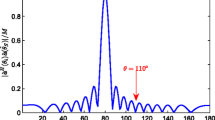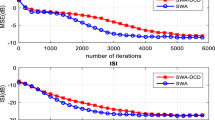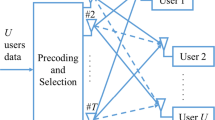Abstract
A new semi-blind adaptive beamforming scheme is proposed for multi-input multi-output (MIMO) induced and space-division multiple-access based wireless systems that employ high order phase shift keying signaling. A minimum number of training symbols, very close to the number of receiver antenna elements, are used to provide a rough initial least squares estimate of the beamformer’s weight vector. A novel cost function combining the constant modulus criterion with decision-directed adaptation is adopted to adapt the beamformer weight vector. This cost function can be approximated as a quadratic form with a closed-form solution, based on which we then derive the recursive least squares (RLS) semi-blind adaptive beamforming algorithm. This semi-blind adaptive beamforming scheme is capable of converging fast to the minimum mean-square-error beamforming solution, as demonstrated in our simulation study. Our proposed semi-blind RLS beamforming algorithm therefore provides an efficient detection scheme for the future generation of MIMO aided mobile communication systems.
Similar content being viewed by others
References
Cisco Visual networking index: Global mobile data traffic forecast update, 2016-2021 White Paper. [Online], Available: http: www.cisco.com/c/en/us/solutions/collateral/service-provider/visual-networking-indexvni/mobile-white-paper-c11-520862.html, February 09, 2017.
J. H. Winters, J. Salz, R. D. Gitlin. The impact of antenna diversity on the capacity of wireless communication systems. IEEE Transactions on Communications, vol. 42, no. 2–4, pp. 1740–1751, 1994.
J. Litva, T. K. Y. Lo, Digital Beamforming in Wireless Communications, London, UK: Artech House, 1996.
R. Kohno. Spatial and temporal communication theory using adaptive antenna array. IEEE Personal Communications, vol. 5, no.1, pp. 28–35, 1998.
J. H. Winters. Smart antennas for wireless systems. IEEE Personal Communications, vol. 5, no.1, pp. 23–27, 1998.
J. S. Blogh, L. Hanzo, Third Generation Systems and Intelligent Wireless Networking: Smart Antennas and Adaptive Modulation, Chichester, UK: John Wiley, 2002.
P. Vandenameele, L. Van Der Perre, M. Engels. Space Division Multiple Access for Wireless Local Area Networks, Boston, USA: Kluwer Academic Publishers, 2001.
A. Paulraj, R. Nabar, D. Gore, Introduction to Space-Time Wireless Communications, Cambridge, UK: Cambridge University Press, 2003.
A. J. Paulraj, D. A. Gore, R. U. Nabar, H. Bölcskei. An overview of MIMO communications-a key to gigabit wireless. Proceedings of the IEEE, vol. 92, no.2, pp. 198–218, 2004.
S. Sugiura, S. Chen, L. Hanzo. A unified MIMO architecture subsuming space shift keying, OSTBC, BLAST and LDC. In Proceedings of the 72nd Vehicular Technology Conference Fall, IEEE, Ottawa, Canada, pp. 1–5, 2010.
S. Sugiura, S. Chen, L. Hanzo. MIMO-aided near-capacity turbo transceivers: Taxonomy and performance versus complexity. IEEE Communications Surveys & Tutorials, vol. 14, no.2, pp. 421–442, 2012.
F. Rusek, D. Persson, B. K. Lau, E. G. Larsson, T. L. Marzetta, O. Edfors, F. Tufvesson. Scaling up MIMO: Opportunities and challenges with very large arrays. IEEE Signal Processing Magazine, vol. 30, no.1, pp. 40–60, 2013.
E. G. Larsson, O. Edfors, F. Tufvesson, T. L. Marzetta. Massive MIMO for next generation wireless systems. IEEE Communications Magazine, vol. 52, no.2, pp. 186–195, 2014.
T. L. Marzetta. Massive MIMO: An introduction. Bell Labs Technical Journal, vol. 20, pp. 11–22, 2015.
S. Chen, N. N. Ahmad, L. Hanzo. Adaptive minimum biterror rate beamforming. IEEE Transactions on Wireless Communications, vol. 4, no.2, pp. 341–348, 2005.
S. Chen, L. Hanzo, N. N. Ahmad, A. Wolfgang. Adaptive minimum bit error rate beamforming assisted receiver for QPSK wireless communication. Digital Signal Processing, vol. 15, no.6, pp. 545–567, 2005.
S. Chen, L. Hanzo, A. Livingstone. MBER space-time decision feedback equalization assisted multiuser detection for multiple antenna aided SDMA systems. IEEE Transactions on Signal Processing, vol. 54, no.8, pp. 3090–3098, 2006
S. Chen. Adaptive beamforming assisted receiver. Handbook on Advancements in Smart Antenna Technologies for Wireless Networks, C. Sun, J. Cheng, T. Ohira, Eds., London, UK: Information Science Reference, pp. 68–92, 2008.
X. Hong, S. Chen. A minimum approximate-BER beamforming approach for PSK modulated wireless systems. International Journal of Automation and Computing, vol.5, no.3, pp. 284–289, 2008.
B. R. Vojčić, W. M. Jang. Transmitter precoding in synchronous multiuser communications. IEEE Transactions on Communications, vol. 46, no.10, pp. 1346–1355, 1998.
W. Yao, S. Chen, S. Tan, L. Hanzo. Minimum bit error rate multiuser transmission designs using particle swarm optimisation. IEEE Transactions on Wireless Communications, vol. 8, no.10, pp. 5012–5017, 2009.
W. Yao, S. Chen, L. Hanzo. Generalized MBER-based vector precoding design for multiuser transmission. IEEE Transactions on Vehicular Technology, vol. 60, no.2, pp. 739–745, 2011.
W. Yao, S. Chen, L. Hanzo. Particle swarm optimisation aided MIMO multiuser transmission designs. Journal of Computational and Theoretical Nanoscience, vol. 9, no.2, pp. 266–275, 2012.
X. D. Zhu, Z. C. Wang, C. Qian, L. L. Dai, J. H. Chen, S. Chen, L. Hanzo. Soft pilot reuse and multicell block diagonalization precoding for massiveMIMO systems. IEEE Transactions on Vehicular Technology, vol. 65, no.5, pp. 3285–3298, 2016.
M. Biguesh, A. B. Gershman. Training-based MIMO channel estimation: A study of estimator tradeoffs and optimal training signals. IEEE Transactions on Signal Processing, vol. 54, no.3, pp. 884–893, 2006.
B. Widrow, P. E. Mantey, L. J. Griffiths, B. B. Goode. Adaptive antenna systems. Proceedings of the IEEE, vol. 55, no.12, pp. 2143–2159, 1967.
L. J. Griffiths. A simple adaptive algorithm for real-time processing in antenna arrays. Proceedings of the IEEE, vol. 57, no.10, pp. 1696–1704, 1969.
S. Haykin, Adaptive Filter Theory, 3rd ed., Upper Saddle River, USA: Prentice Hall, 1996.
J. J. Shynk, R. P. Gooch. The constant modulus array for cochannel signal copy and direction finding. IEEE Transactions on Signal Processing, vol. 44, no.3, pp. 652–660, 1996.
J. Sheinvald. On blind beamforming for multiple non- Gaussian signals and the constant-modulus algorithm. IEEE Transactions on Signal Processing, vol. 46, no.7, pp. 1878–1885, 1998.
K. H. Yang, T. Ohira, Y. M. Zhang, C. Y. Chi. Superexponential blind adaptive beamforming. IEEE Transactions on Signal Processing, vol. 52, no.6, pp. 1549–1563, 2004.
E. de Carvalho, D. T. M. Slock. Blind and semi-blind FIR multichannel estimation: (Global) identifiability conditions. IEEE Transactions on Signal Processing, vol. 52, no.4, pp. 1053–1064, 2004.
C. Shin, R. W. Heath, E. J. Powers. Blind channel estimation for MIMO-OFDM systems. IEEE Transactions on Vehicular Technology, vol. 56, no.2, pp. 670–685, 2007.
L. Tong, R. W. Liu, V. C. Soon, Y. F. Huang. Indeterminacy and identifiability of blind identification. IEEE Transactions on Circuits and Systems, vol. 38, no.5, pp. 499–509, 1991.
C. Cozzo, B. L. Hughes. Joint channel estimation and data detection in space-time communications. IEEE Transactions on Communications, vol. 51, no.8, pp. 1266–1270, 2003.
S. Buzzi, M. Lops, S. Sardellitti. Performance of iterative data detection and channel estimation for singleantenna and multiple-antennas wireless communications. IEEE Transactions on Vehicular Technology, vol. 53, no.4, pp. 1085–1104, 2004.
S. Chen, S. Sugiura, L. Hanzo. Semi-blind joint channel estimation and data detection for space-time shift keying systems. IEEE Signal Processing Letters, vol. 17, no.12, pp. 993–996, 2010.
P. C. Zhang, S. Chen, L. Hanzo. Reduced-complexity nearcapacity joint channel estimation and three-stage turbo detection for coherent space-time shift keying. IEEE Transactions on Communications, vol. 61, no.5, pp. 1902–1913, 2013.
P. C. Zhang, S. Chen, L. Hanzo. Embedded iterative semi-blind channel estimation for three-stage-concatenated MIMO-aided QAM turbo transceivers. IEEE Transactions on Vehicular Technology, vol. 63, no.1, pp. 439–446, 2014.
S. Chen, W. Yao, L. Hanzo. Semi-blind adaptive beamforming for high-throughput quadrature amplitude modulation systems. International Journal of Automation and Computing, vol. 7, no.4, pp. 565–570, 2010.
Y. X. Chen, L. Le-Ngoc, B. Champagne, C. J. Xu. Recursive least squares constant modulus algorithm for blind adaptive array. IEEE Transactions on Signal Processing, vol. 52, no.5, pp. 1452–1456, 2004.
Author information
Authors and Affiliations
Corresponding author
Additional information
Recommended by Associate Editor Qing-Long Han
Xia Hong received the B. Sc. and M. Sc. degrees from the National University of Defense Technology, China, in 1984 and 1987, respectively, and received the Ph.D. degree from The University of Sheffield, UK in 1998, all in automatic control. She was a research assistant with the Beijing Institute of Systems Engineering, China, from 1987 to 1993. She was a research fellow with the Department of Electronics and Computer Science, University of Southampton, UK from 1997 to 2001. She is currently a professor with the Department of Computer Science, School of Mathematical, Physical and Computational Sciences, University of Reading, UK. She has authored over 200 research papers, and co-authored a research book. She received the Donald Julius Groen Prize from IMechE in 1999.
Her research interests include nonlinear systems identification, data modelling, estimation and intelligent control, neural networks, pattern recognition, learning theory and their applications.
Sheng Chen received the B.Eng. degree in control engineering from the East China Petroleum Institute, China in 1982, received the Ph.D. degree in control engineering from City University, UK in 1986, and received the D. Sc. degree from the University of Southampton, UK in 2005. From 1986 to 1999, he held research and academic appointments at The University of Sheffield, UK, the University of Edinburgh, UK, and the University of Portsmouth, UK. Since 1999, he has been with the Electronics and Computer Science, University of Southampton, UK, where he is currently a professor in intelligent systems and signal processing. He has authored over 550 research papers. He is a Fellow of IET, a Distinguished Adjunct Professor with King Abdulaziz University, Saudi Arabia, and an ISI highly cited researcher in engineering in 2004. He was elected to a Fellow of the United Kingdom Royal Academy of Engineering in 2014.
His research interests include adaptive signal processing, wireless communications, modeling and identification of nonlinear systems, neural network and machine learning, intelligent control system design, evolutionary computation methods, and optimisation.
Rights and permissions
About this article
Cite this article
Hong, X., Chen, S. Recursive least squares semi-blind beamforming for MIMO using decision directed adaptation and constant modulus criterion. Int. J. Autom. Comput. 14, 442–449 (2017). https://doi.org/10.1007/s11633-017-1087-6
Received:
Accepted:
Published:
Issue Date:
DOI: https://doi.org/10.1007/s11633-017-1087-6




